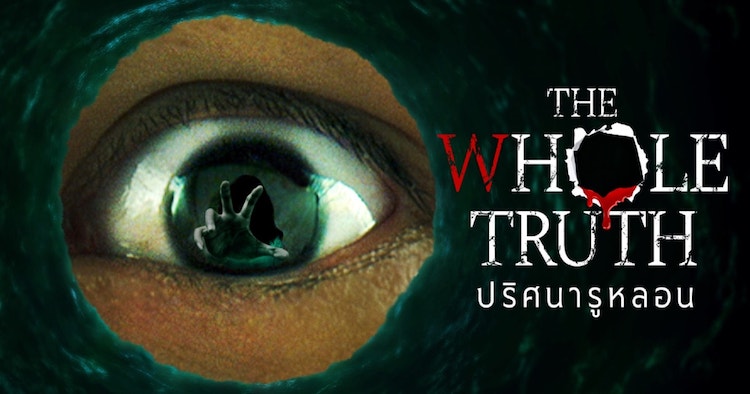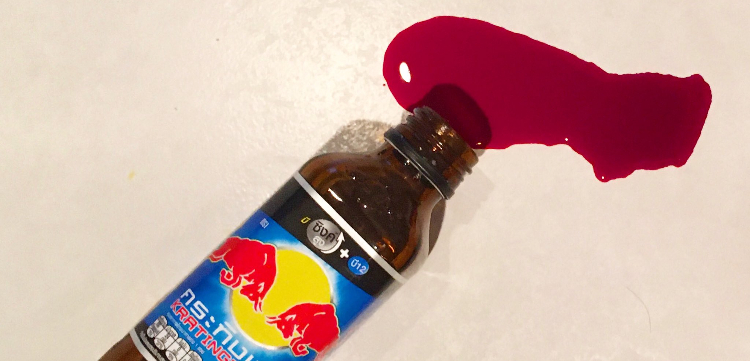
Wisit Sasanatieng’s new film The Whole Truth (ปริศนารูหลอน) premiered on Netflix earlier this month. It’s the director’s fourth supernatural horror film, meaning that ghost films now make up the majority of his filmography. His two most recent films, Reside (สิงสู่) and Senior (รุ่นพี่), were also about ghosts, though The Whole Truth is more satisfying than either of them. His first ghost film, The Unseeable (เปนชู้กับผี), climaxed with a series of plot twists revealed in rapid succession, tying up all the loose ends at the last minute. Fortunately, the twists in The Whole Truth make more sense, and the ending is genuinely touching.
Two teenagers have to stay at their grandparents’ house after their mother is injured in a car crash, but after they arrive, a mysterious peephole appears, through which they see the apparition of a dead child. The film’s title is a pun on ‘whole’ and ‘hole’, as the hole is a portal revealing the whole truth of the family’s past. The figures on the other side of the hole are surprisingly clichéd, though: another long-haired ghost slowly crawling towards us, two decades after Ring (リング).
Wisit is a superb visual stylist, which is evident throughout The Whole Truth, especially in the establishing shots. He occasionally places the camera directly overhead, most effectively during a party sequence in a circular room, and these crane shots hint at the unsettling history behind the veneer of the grandparents’ neat and tidy house.
The film is most remarkable for its social commentary. Thai studios and TV networks generally err on the side of caution, partly to avoid Thailand’s criminal defamation law. Netflix, on the other hand, has produced several recent Thai dramas that tackle issues such as corruption and discrimination head-on. One of the plot twists in The Whole Truth concerns social attitudes towards disability, and the film is also a thinly-veiled dramatisation of the Vorayuth Yoovidhya hit-and-run case. (Vorayuth is a major shareholder in Red Bull, known in Thailand as Kratindaeng.)
Two teenagers have to stay at their grandparents’ house after their mother is injured in a car crash, but after they arrive, a mysterious peephole appears, through which they see the apparition of a dead child. The film’s title is a pun on ‘whole’ and ‘hole’, as the hole is a portal revealing the whole truth of the family’s past. The figures on the other side of the hole are surprisingly clichéd, though: another long-haired ghost slowly crawling towards us, two decades after Ring (リング).
Wisit is a superb visual stylist, which is evident throughout The Whole Truth, especially in the establishing shots. He occasionally places the camera directly overhead, most effectively during a party sequence in a circular room, and these crane shots hint at the unsettling history behind the veneer of the grandparents’ neat and tidy house.
The film is most remarkable for its social commentary. Thai studios and TV networks generally err on the side of caution, partly to avoid Thailand’s criminal defamation law. Netflix, on the other hand, has produced several recent Thai dramas that tackle issues such as corruption and discrimination head-on. One of the plot twists in The Whole Truth concerns social attitudes towards disability, and the film is also a thinly-veiled dramatisation of the Vorayuth Yoovidhya hit-and-run case. (Vorayuth is a major shareholder in Red Bull, known in Thailand as Kratindaeng.)

Driving while intoxicated, Vorayuth killed police officer Wichian Klanprasert in 2012, though the police investigation into the case was delayed, causing understandable public outrage. After the car crash in The Whole Truth, the young son of another wealthy family brags about his immunity from prosecution: “The district police is on my father’s payroll anyway.” When confronted by the children’s grandfather, he boasts: “Thai law can’t touch me, don’t you know that?”
Other recent Thai Netflix productions have dealt with similar scandals. Minnie and the Four Bodies (มินนี่ 4 ศพ), an episode from the second season of Girl from Nowhere: The Series (เด็กใหม่ 2), was inspired by the case of Thephasadin Na Ayudhya, who killed nine people while driving underage in 2010 yet avoided jail. The episode features a similar crash, after which the young girl driver’s father is seen bribing the police chief, and the girl is tortured in a cathartic dream sequence. The show’s prologue gets straight to the point, describing Thailand as “a country where there’s no place for the poor, and no consequences for the rich”.
Another Thai Netflix drama series, Bangkok Breaking — directed by Kongkiat Khomsiri, who made the intense thriller Slice (เฉือน) — deals with corruption among the ‘body snatchers’ who transport accident victims to hospital. The show’s Thai title, มหานครเมืองลวง, translates as ‘city of deception’, which would surely have been changed by the censors if it was submitted for theatrical or video release.
Other recent Thai Netflix productions have dealt with similar scandals. Minnie and the Four Bodies (มินนี่ 4 ศพ), an episode from the second season of Girl from Nowhere: The Series (เด็กใหม่ 2), was inspired by the case of Thephasadin Na Ayudhya, who killed nine people while driving underage in 2010 yet avoided jail. The episode features a similar crash, after which the young girl driver’s father is seen bribing the police chief, and the girl is tortured in a cathartic dream sequence. The show’s prologue gets straight to the point, describing Thailand as “a country where there’s no place for the poor, and no consequences for the rich”.
Another Thai Netflix drama series, Bangkok Breaking — directed by Kongkiat Khomsiri, who made the intense thriller Slice (เฉือน) — deals with corruption among the ‘body snatchers’ who transport accident victims to hospital. The show’s Thai title, มหานครเมืองลวง, translates as ‘city of deception’, which would surely have been changed by the censors if it was submitted for theatrical or video release.


